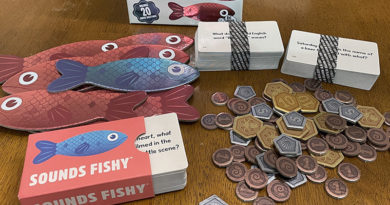Relative Insanity: See What I Mean?! game review
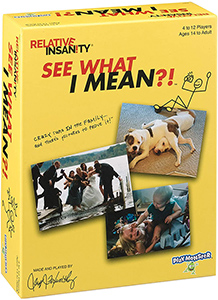
“There are few certainties in life. One of them is everybody’s relatives are crazy. You can let them make you nuts too, or you can learn to laugh about it. I prefer laughter every time.” — Jeff Foxworthy
And when you get a game with Jeff Foxworthy’s name emblazoned on it, you can expect laughter.
That’s definitely the case with Relative Insanity: See What I Mean?! by PlayMonster.
And you don’t even have to reveal any family secrets.
Instead, you just have to choose funny captions for the crazy photos in the game.
How to play Relative Insanity: See What I Mean?!
Relative Insanity: See What I Mean?! is a simple game to explain and play — especially if you’re familiar with Apples to Apples, Bubble Talk, and/or Sounds Like a Plan.
That’s because the game feels like a mash-up of all those games — where one player is the judge each round and chooses from among the cards the other players submit.
The game comes with 100 Photo cards that show crazy photos of people or animals doing who knows what. It also comes with 300 Caption cards – each with 3 phrases.
Players begin with a hand of 7 Caption cards and one player is chosen to be the first Judge.
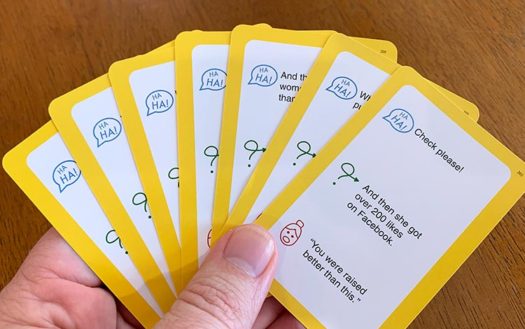
The Judge draws a Photo card and rolls the die.
All other players look at their hand of cards to find a funny caption related to the die result. The 3 options are a Punchline (Ha Ha), What Happened Next, and What Grandma Would Say.
Players give their chosen cards to the Judge who shuffles them and then reads them one by one.
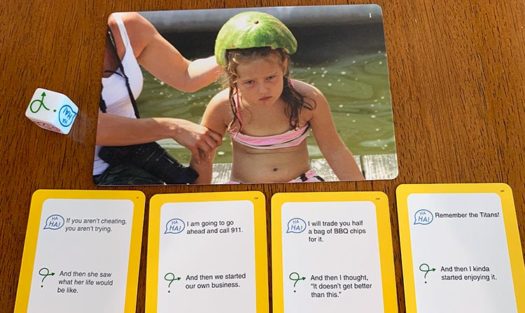
After the laughter dies down, the Judge selects the First Place and Second Place cards. Those players get 2 points and 1 point respectively. The Judge can also give out the Black Sheep marker for the worst card (no points, just for fun).
Players replenish their hand to 7 cards and the player to the left of the Judge becomes the new Judge for the next round.
After playing the previously chosen number of rounds, the player with the most points wins.
That’s all there is to it.
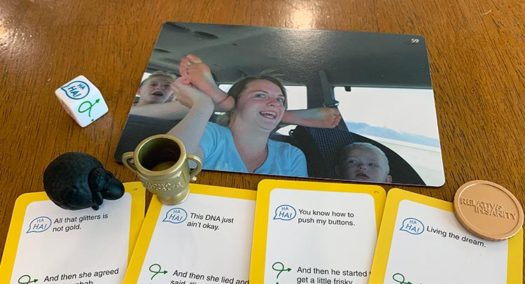
Can the whole family enjoy Relative Insanity: See What I Mean?
As you might guess, the very simple play of Relative Insanity: See What I Mean?! means that almost everyone in the family can play.
So we were surprised to see “Ages 14+” printed on the game box.
Yes, players need to be able to read the captions on their cards. But 14+ still seemed kind of high for that factor.
However, the question was quickly answered with the first Photo card we drew in our first game. It wasn’t a photo we’d want to come up in a game with younger kids. We’d rate it PG-13 and tossed it from our copy of the game.
From there on out though we had a great time and ended up playing many more rounds than we’d planned for our first play.
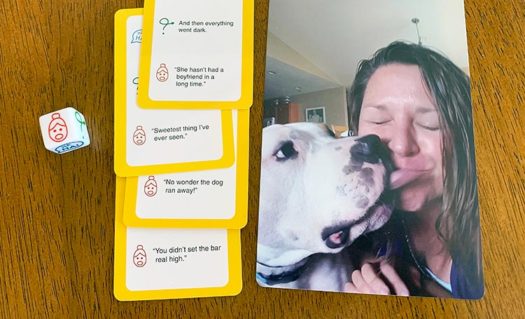
As we mentioned before, the gameplay feels like a mash-up of Bubble Talk and Sounds Like a Plan. In Bubble Talk, players are providing funny captions for crazy photos. And in Sounds Like a Plan, the judge rolls a die that determines the frame of reference the responses should take.
But what we like about Relative Insanity beyond those family favorite games is that each caption card has 3 responses on it and they’re specifically tailored to a certain situation.
After playing a number of rounds, we all started hoping that we’d roll “What Grandma Would Say” because we got the biggest laughs out of those. Our next favorite are the What Happened Next captions. Those often turned into hilarious moments as they were revealed.
In fact, a couple times while reading the What Happened Next responses it felt like a whole story unfolding. Then happened, and then this, and then this… and each step would get bigger laughs because of how they played out.

Another thing we started doing for fun was throwing in an extra card from the deck each round. After we’d each selected our cards to give the Judge, the Judge would draw a random card and add it to the options. Then the Judge would shuffle, reveal, read, and choose.
And we’d especially get a kick out of it when the random card tossed in would be awarded points!
And even though we keep score while playing and have an ultimate winner, Relative Insanity feels more like just a fun activity to do while kicking back with family. It really doesn’t matter who gets the highest score because the fun is in the playing.
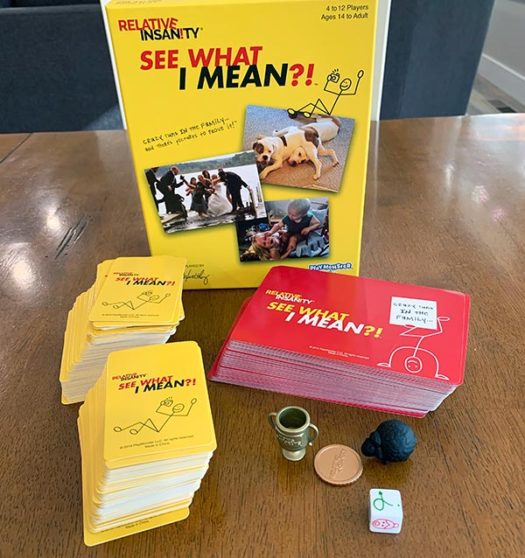
How does Relative Insanity: See What I Mean?! score on our “Let’s Play Again” game meter?
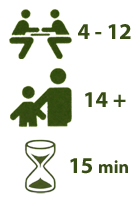 Relative Insanity: See What I Mean?! definitely gets a spot on our party game shelf. It may seem like 100 Photo cards are a lot. But when you play many more rounds than planned, you’ll go through the deck more quickly than you’ll think as well.
Relative Insanity: See What I Mean?! definitely gets a spot on our party game shelf. It may seem like 100 Photo cards are a lot. But when you play many more rounds than planned, you’ll go through the deck more quickly than you’ll think as well.
But the cool thing is that even when you circulate through the cards, the results will turn out differently because of the huge variety of caption cards and the random roll of the die. One time you’ll caption a card with what grandma would say and the next time you’ll be looking for punchlines.
And if you really want to get crazy, just pull out the family photo albums and use your own family photos!
Grab a copy of Relative Insanity: See What I Mean?! for your family gatherings.
We’d like to thank PlayMonster for a review copy of Relative Insanity: See What I Mean?!



